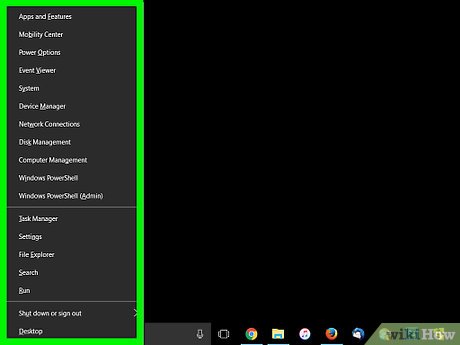How to Open Command Prompt with a Keyboard Shortcut (Windows 8, 8.1, and 10)
Method 1 of 2:
Opening a Regular Command Prompt Window
-
 Press and hold the ⊞ Win key.
Press and hold the ⊞ Win key. -
 Press and hold the X key.
Press and hold the X key. -
 Release the two keys. A context menu should appear in the lower-left corner of your screen, just above the Startbutton.
Release the two keys. A context menu should appear in the lower-left corner of your screen, just above the Startbutton.
-
 Press the C key.
Press the C key. -
 Begin using the Command Prompt. Type a command into the Command Prompt window and hit ↵ Enter to initiate it.
Begin using the Command Prompt. Type a command into the Command Prompt window and hit ↵ Enter to initiate it.
Method 2 of 2:
Opening an Administrator Command Prompt Window
-
 Press and hold the ⊞ Win key.
Press and hold the ⊞ Win key. -
 Press and hold the X key.
Press and hold the X key. -
 Release the two keys. A context menu should appear in the lower-left corner of your screen, just above the Startbutton.
Release the two keys. A context menu should appear in the lower-left corner of your screen, just above the Startbutton.
-
 Press the A key.
Press the A key. -
 Provide confirmation in the User Account Control window if prompted. You might need to type the password to an administrator account. Then click or tap Yes at the bottom of the window to continue.
Provide confirmation in the User Account Control window if prompted. You might need to type the password to an administrator account. Then click or tap Yes at the bottom of the window to continue. -
 Begin using the Command Prompt. Type a command into the Command Prompt window and hit ↵ Enter to initiate it.
Begin using the Command Prompt. Type a command into the Command Prompt window and hit ↵ Enter to initiate it.
4.7 ★ | 3 Vote
You should read it
- How to Customize the Font in Windows Command Prompt
- How to activate Ctrl + C / Ctrl + V to execute paste command in Command Prompt window?
- How to Watch Star Wars on Command Prompt
- Color command in Windows
- Add Command Prompt to Power User Menu on Windows 10
- How to open Command Prompt on Windows 10, 8, 7, Vista and XP
- How to Make Command Prompt Appear at School
- 6 Best Command Prompt Alternatives for Windows
May be interested
- How to Run Command Prompt Commands from a Windows Shortcut
 to create a windows shortcut that runs a command at the command prompt, right-click the desktop → select 'shortcut' → enter the command (prefaced by '|%comspec% /k' → click 'next' → enter a name for the shortcut → click 'finish'. right-cli...
to create a windows shortcut that runs a command at the command prompt, right-click the desktop → select 'shortcut' → enter the command (prefaced by '|%comspec% /k' → click 'next' → enter a name for the shortcut → click 'finish'. right-cli... - How to Set a Keyboard Shortcut to Open Spotlight
 to open spotlight using the default keyboard shortcut, press the command key (⌘) and tap the space bar. you can also click on the magnifying glass in the menu bar or set your own, custom keyboard shortcut using the 'keyboard' settings u...
to open spotlight using the default keyboard shortcut, press the command key (⌘) and tap the space bar. you can also click on the magnifying glass in the menu bar or set your own, custom keyboard shortcut using the 'keyboard' settings u... - How to add 'Open command window here as administrator' to the right-click menu on Windows 10
 the command prompt is an entry point for typing computer commands in the command prompt window. by typing the command at the command prompt, you can perform tasks on the computer without using the graphical interface of windows. this tutorial will show you how to add or remove open command window here as administrator in the right-click menu on windows 10.
the command prompt is an entry point for typing computer commands in the command prompt window. by typing the command at the command prompt, you can perform tasks on the computer without using the graphical interface of windows. this tutorial will show you how to add or remove open command window here as administrator in the right-click menu on windows 10. - How to open Command Prompt during Windows installation
 opening command prompt while you install windows will help you use commands in cmd such as checking drive health, converting standard mbr - gpt and many other benefits,
opening command prompt while you install windows will help you use commands in cmd such as checking drive health, converting standard mbr - gpt and many other benefits, - How to Make Command Prompt Appear at School
 this wikihow teaches you how to access command prompt on a windows 10 school computer. although you may be able to open command prompt if only the file path to command prompt is blocked, there is no way to bypass an administrator lock on...
this wikihow teaches you how to access command prompt on a windows 10 school computer. although you may be able to open command prompt if only the file path to command prompt is blocked, there is no way to bypass an administrator lock on... - How to open Microsoft Word from Command Prompt
 like most applications, you can launch word from command prompt. however, word also supports some optional switches to control the boot process.
like most applications, you can launch word from command prompt. however, word also supports some optional switches to control the boot process. - How to Watch Star Wars on Command Prompt
 this wikihow teaches you how to watch a version of 'star wars' rendered entirely in ascii characters (by folks with a lot of free time) using command prompt on windows or terminal on mac. open command prompt. you can open command prompt by...
this wikihow teaches you how to watch a version of 'star wars' rendered entirely in ascii characters (by folks with a lot of free time) using command prompt on windows or terminal on mac. open command prompt. you can open command prompt by... - How to find and open files with Command Prompt
 once you've learned how to navigate folders on windows 10, the next step is to learn how to find and open files with command prompt. this is as easy as navigating and opening a file in file explorer.
once you've learned how to navigate folders on windows 10, the next step is to learn how to find and open files with command prompt. this is as easy as navigating and opening a file in file explorer. - 12 ways to open CMD - Command Prompt easily on Windows 10
 open the command line, open cmd or open command prompt on windows is not difficult, but do you know how to open this command line interface? please refer to 12 ways to open cmd below.
open the command line, open cmd or open command prompt on windows is not difficult, but do you know how to open this command line interface? please refer to 12 ways to open cmd below. - How to Open Terminal in Windows
 this wikihow teaches you how to open the command prompt terminal window, using a windows pc. you can open the command prompt from your start menu or from any folder in the file explorer. you can also use the windows run feature. open your...
this wikihow teaches you how to open the command prompt terminal window, using a windows pc. you can open the command prompt from your start menu or from any folder in the file explorer. you can also use the windows run feature. open your...














 How to Add New Options to Right Click Menu in Windows
How to Add New Options to Right Click Menu in Windows How to Unblock Command Prompt Anywhere
How to Unblock Command Prompt Anywhere How to Hide a File in an Image File
How to Hide a File in an Image File How to Fix Full Screen Command Prompt
How to Fix Full Screen Command Prompt How to Use DOSBox
How to Use DOSBox How to Add and Delete Users Accounts With Command Prompt in Windows
How to Add and Delete Users Accounts With Command Prompt in Windows